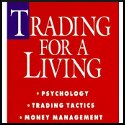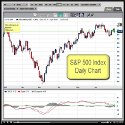Triple Call Technique
September 19, 2009 | No Comments | Course

You’ll find that most techniques for trading are not rocket science. In fact most of the difference between traders who make money and traders who lose money is about discipline, not about technique. That being said, there are some approaches that I feel can help broaden your toolbox and could be a missing component for some traders. Today I’m going to talk about what I call the “Triple Call Technique.”
I utilize this approach in several situations:
- One is in a market like now, where I lack conviction and I feel that overall the issue I’m looking at might be trading in a line. In cases where I’d like to go long something, but I’m feeling very risk averse this method can be great. It works particularly well going long on issues that pay a high dividend.
- Another is when I’m looking to hedge a position. Typically when I’m hedging I’m trying to pick the issue most likely to benefit if I’m wrong and give myself a small upside on that position. This can also be useful in markets like today’s where I tend to lack conviction in any fundamental sense.
- Finally I can use this in auto-trading systems where I’m trying to build up a position in something over time. I have a tendency to employ this with ETFs to gain exposure to a certain position over time.
Ultimately the crux of the system is pretty simple. Let’s assume I’m going long but it can be used in exactly the same way to go short. This only works with stocks and ETFs in which you can sell options, so they typically can’t be thinly traded. Typically I set up some type of automated system that will notify when certain criteria are met. One great approach is to use Market Club’s Trade Traingle system and get notifed whenever a particular score is hit. You could also consider using any indicator or combination of indicators, even something as simple as Moving Average crossovers. Once my signal is hit, I take my position and then immediately sell calls as follows:
- 1/3 I sell a deep in the money call.
- 1/3 I sell a slightly out of the money call.
- 1/3 I leave uncovered.
If I’m hedging or otherwise particularly skeptical of the position, I will sometimes not take the uncovered position at all. What you’ve essentially done by doing this is get your cost basis down but severely limit your upside. If the intent of the position is to hedge another position this can be perfect. Additionally if this is a position where you’re likely to get out if it runs very far anyway, then a limited upside isn’t really a liability, since it should be offsetting the limited risk as set by your stop. Meanwhile you’re risk is significantly curtailed. Let’s take an example from today’s prices:
Suppose I want to gain exposure to international sales to offset a bias in my other trading positions. To do this I set a series of watches on Market Club to let me know when any of a series of stocks hits a score of 90. If you’d like to get a FREE score for a stock just sign up here. As of today PM is has a score of 90, which is a strong uptrend so let’s use that as my buy signal. Phillip Morris International closed today at $48.18. Now let’s start with my in the money call. Assuming we’re using Dec calls, here are my possible selection:
| Strike | Price | Premium | Premium/Net Cost | Effective Price |
|---|---|---|---|---|
| $47 | $2.65 | $1.47 | 3.23% | $45.53 |
| $46 | $3.30 | $1.12 | 2.50% | $44.88 |
| $45 | $3.90 | $0.72 | 1.63% | $44.28 |
| $44 | $4.70 | $0.52 | 1.20% | $43.48 |
| $43 | $5.51 | $0.33 | 0.77% | $42.67 |
With these options available, you might be surprised to learn I would take the $43 strike price option. By taking that on 1/3 of my position, I would make 0.88% in 2 months as long as the price stays above 43. If it plummets and goes to $41 then it has brought my price for that block down to $42.67. This makes my hedge less painful if I’m right.
On the second third of my position I would sell a $50 strike price call for $1.20. Then I would leave the final third uncovered. The net result of all this is that my average price is $45.94. Let’s look at what I gain or lose at various prices:
| Price | $43 Strike | $50 Strike | No Call | Total |
|---|---|---|---|---|
| 40 | ($2.67) | ($5.94) | ($8.18) | ($14.12) |
| 45 | $0.33 | ($0.94) | ($3.18) | ($3.79) |
| 48 | $0.33 | $1.02 | ($0.18) | $1.17 |
| 50 | $0.33 | $3.02 | $1.82 | $4.84 |
| 55 | $0.33 | $3.02 | $6.82 | $10.17 |
As you can see, the net effect is that if the stock goes down a lot we lose less than we would have otherwise. If the stock stays about flat you make more than you would have and if the stock goes up you make less than you would have otherwise. Ultimately it dampens your effects in either direction. If I did this over a significant period of time with automatic trading signals and a selection of appropriate stocks, I could build up significant exposure without nearly as much risk. When trying to build up a position, or in unconvincing market the key components are:
1.) Using an Automatic Trade Indicator
2.) Selling staggered options on portions of your position.
When hedging you should simply take the position to offset your other positions. You can see the many applications, especially in environments where you are risk averse.
Photo Credit: Corey Leopold

 If you’re trading without a “stop,” you are playing Russian Roulette with your money. “Stop Loss Orders” or “stops” are orders you place with your brokers to indicate that if your position moves against you to a certain point you will exit the trade. You have a “stop price” where if the issue trades at that price or worse, the order turns into a market order to sell or buy. Many traders don’t actually place the order but have a price at which they will exit the trade, which they still call a “stop.” In fact some traders prefer not to place an actual order because they fear they will influence price execution and get “stopped out” when they wouldn’t have otherwise. Regardless of how you execute the exit, you should never enter any position without a price at which you know you’re wrong and get out of the trade.
If you’re trading without a “stop,” you are playing Russian Roulette with your money. “Stop Loss Orders” or “stops” are orders you place with your brokers to indicate that if your position moves against you to a certain point you will exit the trade. You have a “stop price” where if the issue trades at that price or worse, the order turns into a market order to sell or buy. Many traders don’t actually place the order but have a price at which they will exit the trade, which they still call a “stop.” In fact some traders prefer not to place an actual order because they fear they will influence price execution and get “stopped out” when they wouldn’t have otherwise. Regardless of how you execute the exit, you should never enter any position without a price at which you know you’re wrong and get out of the trade.

